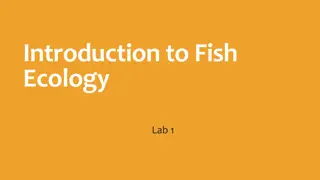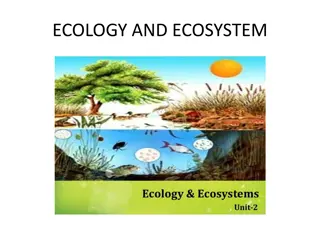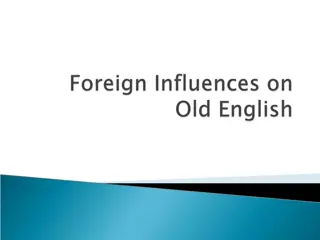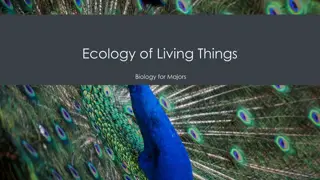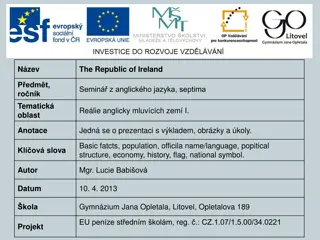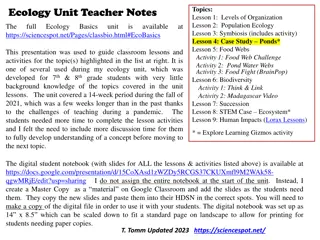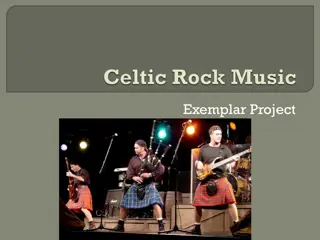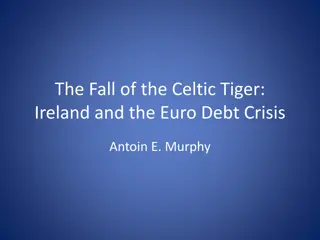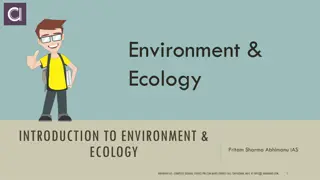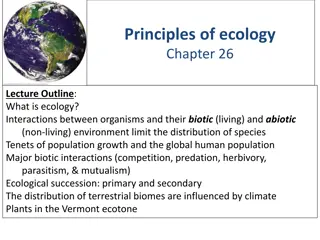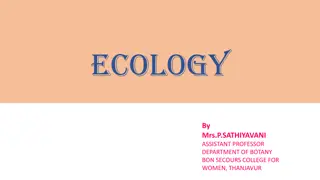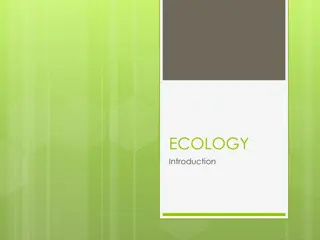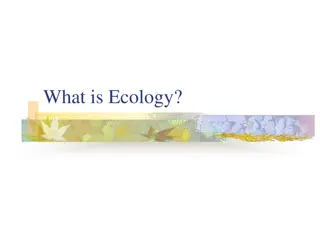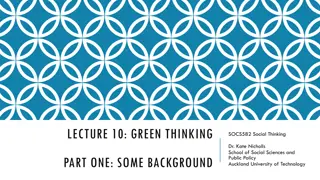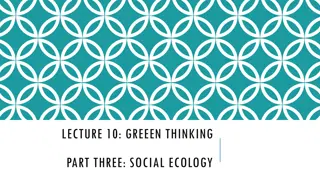
Exploring Celtic Ecology and Historical Relationships
Dive into the world of Celtic ecology and historical connections with this comprehensive course on Celtic origins, oral traditions, pagan beliefs, and more. Discover the significance of the Otherworld, Dúthchas, and the Ulster Cycle as you unravel the ecological study of the home through a multidimensional lens. Explore evidence from oral history, archaeology, scripts, genetics, and linguistic evolution to understand the Celts' cultural successors and trade ecology. Join the quest for a Celtic identity intertwined with nationhood and ecological principles.
Download Presentation

Please find below an Image/Link to download the presentation.
The content on the website is provided AS IS for your information and personal use only. It may not be sold, licensed, or shared on other websites without obtaining consent from the author. If you encounter any issues during the download, it is possible that the publisher has removed the file from their server.
You are allowed to download the files provided on this website for personal or commercial use, subject to the condition that they are used lawfully. All files are the property of their respective owners.
The content on the website is provided AS IS for your information and personal use only. It may not be sold, licensed, or shared on other websites without obtaining consent from the author.
E N D
Presentation Transcript
Celtic Ecology Dr Keith R. Skene Biosphere Research Institute
The Course Week 1: Introduction Celtic Origins: From the East Celtic Origins: From the East or West? Celtic Origins: from the heart? Oral Traditions, the c ilidh house and the expressive arts Pagan beliefs: the Green World and the sagas The Significance of the Otherworld D thchas The Cheshire Cat, Nationhood and identity: In search of a Celtic Ecology Week 2: Week 3: Week 4: Week 5:
Housekeeping Each week, outlines of the lectures, suggested books, papers and websites will be added to the following site (password protected). You should have been sent an email detailing this. Website: www.biosri.org/celticecology Password: biosri6 Contact: krskene@gmail.com
Celtic Ecology: An Introduction Emain Macha
Ecology: the study of the home Historical ecology is a multispacial, multitemporal study of the dynamic relations between humans and their environment Combines social, economic, political and environmental components
Evidence Oral History Archeaology Scripts Cultural successors Genetics Linguistic evolution Trade Ecology
The Celts The first recorded use of the name Celts in ancient Greek was in 517 BC by the Greek geographer Hecataeus of Miletus, who lived near Massilia (now Marseilles) in southern Gaul, using the term (Keltoy) The Romans referred to the Celts as Galli , or the Gauls Another generic term among the Greeks was Galatia .
Thus, as early as the mid-4th century BC at the very latest, the term Celts had become established as the name used in classical Greek ethnography for barbarian communities inhabiting much of Europe, from the coast of the Atlantic Ocean, across much of Western and Central Europe (including considerable parts of the Northwestern shores of the Mediterranean Sea) and down into present day Turkey
The Celts: a major circum-mediterranean group By 450 BC, the Celts were one of the major circum-mediterranean barbarian groups
But who were the Celts? Challenging question Little in terms of written records What records exist are likely highly revisionist A hugely contested issue among current academics.
Politicization of the Celts More recent movements seek to reclaim national identity in a post-colonial world The search for our origins And a deeper identity within our past While others seek to highlight the barbarism of the past, strengthening the belief in the progress of the Enlightenment away from such brutes And the justification of the appropriation of their land as argued by John Locke.
Agris Helmet 350 BC
Plato (c. 350 BC) Plato, in his Laws, classes the Celts (along with the Scythians, Persians, Carthaginians, Iberians and Thracians!!) among the races who were drunken and warlike Their attack on Rome in 390 BC is one of the landmarks of ancient history Much barbarity is attributed to them in the sacking of Delphi in the year 273 BC.
The sacking of Delphi Detail of a terracotta frieze depicting Celtic warriors plundering a temple from Civitalba (Marche), Italy. The scene is believed to represent the sacking of the temple at Delphi by Brennos army.
Strabos early observations on Celts (c. 10BC) All of the Gauls, who are called both Galli and Galatai, are absolutely mad about war. They are high spirited and quickly seek out a fight, but on the other hand, they are sincere and not at all malicious. [. . .] They also possess a lack of seriousness and a love of boasting along with a great affection for ornaments. They wear golden jewelry such as necklaces and bracelets around their arms and wrists, while the upper classes wear dyed clothing decorated with gold. Because of their lightness in character, they are both unbearable to be around when they are victorious, and panic-stricken when things go against them.
Who were the Celts? The Celtosceptics: Professor John Collis, University of Sheffield (1994): There was no cross-European Celtic people. There was no broad-based Celtic art, society, or religion. And there were never any Celts in Britain. Micheal Morse (2005) The Celts are, and always were, a creation of the human mind
Peter Ellis (1990): The Celts were the first European people north of the Alps to emerge into recorded history. At one time they dominated the ancient world from Ireland in the west to Turkey in the east, and from Belgium in the north, south to Spain and Italy
Importance of the Celts across Europe: Plato in the first and Aristotle in the second half of the 4th century BC already refer to the Celts as one as the main barbarian peoples of the ancient world Ptolemy reports that Alexander the Great met ambassadors of the Celts on the lower Danube in 335 BC.
A Pluriverse Many different art styles, habitats and languages At what level do we look for the Celts? What is the unit of culture? Unified by a common essence or a common enemy?
The tout Tribes composed of up to 3000 people with king, poet, justice and priest and seer Around 100 of these in Ireland Across the entirety of Europe, huge regional variation, just as today
Trade Trade links led to artifact, language and cultural diffusion The Celts cannot really be viewed as a uniform, monolithic, unchanging people Emergent dynamic processes, not some museum exhibit Present as well as past
Discussion and break The Kavanagh Charter Horn, County Carlow, Ireland
Week One Lecture II Week One Lecture II Origins Origins Dr Keith R. Skene Biosphere Research Institute
Where did they come from: the three theories From the East From the West From the middle!
1. From the East Origin from East: defined as people that spread from Germany and the Alps between 1600 BC and 100 BC An early Indo-European people.
Eastern Origins Celtic archaeological finds from across Western Europe resemble earlier finds in Austria and Germany East origin worked with the idea of civilization spreading West and with the Proto-Indo-European origin of language in Europe.
Hallstatt three thousand years ago An important salt-mining site and Bronze- to Iron-Age cemetery in Austria The oldest salt mines in the world
Homeland of the Celts Evidence related to grave goods associated with early Celtic identity And later distributed across more western territories The Hallstatt culture was the predominant Western and Central European archaeological culture of the Late Bronze Age (Hallstatt A, Hallstatt B) from the 12th to 8th centuries BC And the Early Iron Age (Hallstatt C, Hallstatt D) from the 8th to 6th centuries BC
Hallstatt salt mine 1,300 burials with Celtic-style grave goods Salt preserved organic material
The Strettweg Cult Wagon from c. 600 BC was found as part of a princely grave of the Hallstatt culture in Strettweg near Judenburg, Austria in 1851.
La Tne Origin from East: La T ne, the designation for the Iron Age after c.450 BC Named after a submerged site on Lake Neuch tel in Switzerland Very few Hallstatt but more numerous LT artifacts are found in the British Isles and Ireland.



